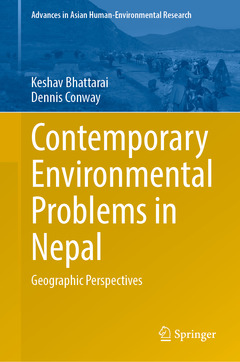Contemporary Environmental Problems in Nepal, 1st ed. 2021 Geographic Perspectives Advances in Asian Human-Environmental Research Series
Auteurs : Bhattarai Keshav, Conway Dennis

This monograph examines contemporary environmental challenges facing Nepal, this landlocked country?s representativeness in the wider South Asian context is both distinct and generalizable. In large part, this is because of its extremes of physiographical structure- plains, hill ranges, mountainous massifs - and wide range of altitudinal terrains, which represent and replicate South Asian and East Asian continental conditions differing as markedly as humid tropical lowlands, sub-tropical hill ranges and temperate to sub-arctic mountainous environments. Associated forest regimes, in which deforestation and reforestation patterns have evolved in recent times, and differing densities of settlement and cleared agricultural landscapes in each of these altitudinal zones, add to the environmental diversity of Nepal. Associated fauna and exotic species are in various states of endangerment especially Bengal tigers, one horned rhinos, wild elephants, crocodile, musk deer, and peasants, to name a few- so that their forested and mountainous habitats as ?Wild Life Reserves? also deserve our attention, and are featured in this monograph?s remit.
Keshav Bhattarai is Professor of Geography at the University of Central Missouri. His research interests are urban planning, demographic studies, migration, land use dynamics, tourism, terrorism, cultural geography, transportation geography, and refugee issues. He has written articles on land use and cover dynamics, tourism and terrorism, demography, urban growth, refugees, forest management, crime mapping, and transportation modeling, and book chapters on cultures, demography, and urban growth. Most of his research concentration is in Nepal. He has co-authored Historical Dictionary of Nepal with Nanda Shrestha. He has also written two books on Nepal’s forest management. He did his Ph. D. under the supervision of Prof. Dennis Conway. He has received research grants from the Ford Foundation, Indian Space Grant, and University Research Council of the University of Central Missouri. He teaches Economic Geography, Geography of Asia, Geography of the Middle East, Research Methods, Conservation Geography, Political Geography, Environmental Geography, Urban Geography, Cartography, Geographic Information Systems (GIS), remote sensing, Global Positioning System courses along with the regional courses of Europe and Asia.
Dennis Conway is Professor emeritus of Geography at Indiana University, Bloomington, USA. His research interests span development geography, urban geography, population geography, transnational migration, globalization’s influences on temporary, irregular and legal mobility patterns and processes and contemporary Caribbean tourism and development. He has written over 140 articles and book chapters with their regional focus being two dramatically different geographical contexts- contemporary Nepal and the Commonwealth Caribbean. In Nepal, his research has examined migration and development issues, human-environment relationships, deforestation and forest settlement dynamics. In the Caribbean, his interests were broade
This book will utilize many empirical examples of environmental cases spanning the diverse landscapes of Nepal to demonstrate how useful information GIS tools can be in effective decision making and record keeping in such a problematic South Asian ‘developing country’
Through various examples, this book will demonstrate how possible it is to save planning time for development engineers who often spend 40% to 60% of their time while validating information. GIS can reduce such project delivery time by 20% to 50%
This book presents cases how GIS can help in the improvement of data management through a better understanding of spatial phenomena. It will present illustrated examples how GIS application incorporates mathematical methods to utilize locational information to connect various disciplines, such as biology, epidemiology, ethnology, geography, sociology and statistics
Through the uses of GIS, remote sensing, GPS, and statistical procedures, this book brings together different applications of spatial analysis methods for understanding geographic variation of certain entities while considering various spatial effects
This book also does certain spatial analysis, modelling and simulation techniques for solving location problems and informing spatial allocation and deployment of resources
It also presents case studies of participatory forest management using a spatial–temporal model. Furthermore, this book analyzes the paths of forest degradation and regeneration and villagers’ utility before and after an access restriction. These approaches will help to improve both forest quality and villagers’ livelihoods. Our examples presented in this book will be useful worldwide both in academics and real world problem solving
Date de parution : 11-2020
Ouvrage de 764 p.
15.5x23.5 cm
Disponible chez l'éditeur (délai d'approvisionnement : 15 jours).
Prix indicatif 168,79 €
Ajouter au panier


